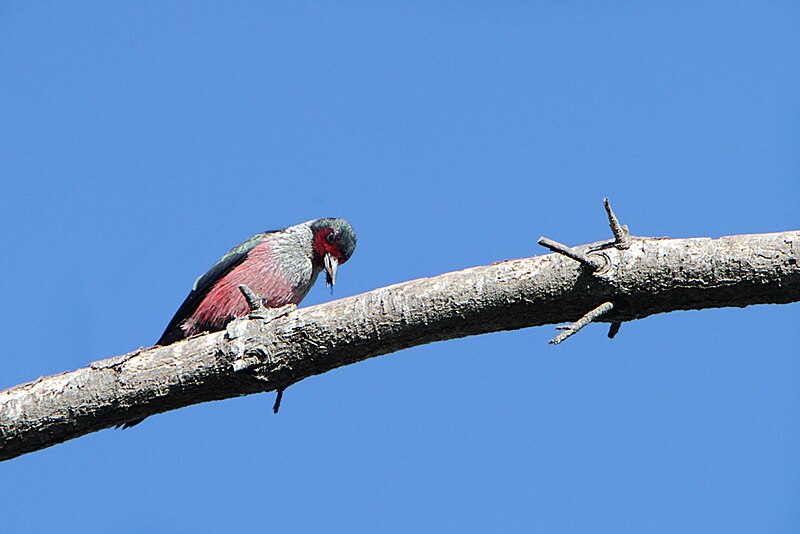The Lewis's Woodpecker, Melanerpes lewis, is a large North American species of woodpecker which was named for Meriwether Lewis, one of the explorers who surveyed the areas bought by the United States of America during the Louisiana Purchase.
Contents [hide]
1 Description
2 Range and habitat
3 Feeding
4 Breeding
Description
 One of the largest species of American woodpeckers, Lewis's Woodpecker can be as large as 10 to 11 inches in length. It is mainly reddish-breasted, blackish-green in color with a black rump. It has a gray collar and upper breast, with a pinkish belly, and a red face. The wings are much broader than those of other woodpeckers, and it flies at a much more sluggish pace with slow, but even flaps similar to those of a crow.
One of the largest species of American woodpeckers, Lewis's Woodpecker can be as large as 10 to 11 inches in length. It is mainly reddish-breasted, blackish-green in color with a black rump. It has a gray collar and upper breast, with a pinkish belly, and a red face. The wings are much broader than those of other woodpeckers, and it flies at a much more sluggish pace with slow, but even flaps similar to those of a crow.Range and habitat
Lewis's Woodpecker is locally common, dwelling mostly in open pine woodlands, and other areas with scattered trees. Unlike other American woodpeckers, it enjoys sitting in the open as opposed to sitting in heavy tree cover. It ranges mostly in the western to central United States, but can winter as far south as the US border with Mexico and summer as far north as Canada.
Feeding
Feeding
 Lewis's Woodpecker engages in some rather un-woodpecker-like behavior in its gregarious feeding habits. Although it does forage for insects by boring into trees with its chisel-like bill, the bird also catches insects in the air during flight, (typical insect hawking), a habit that only a few other woodpeckers, such as the Acorn woodpecker, the Red-headed Woodpecker and the Northern flicker, engage in. Lewis's Woodpecker also feeds on berries and nuts, and will even shell and store nuts in cracks and holes in wood to store until winter.
Lewis's Woodpecker engages in some rather un-woodpecker-like behavior in its gregarious feeding habits. Although it does forage for insects by boring into trees with its chisel-like bill, the bird also catches insects in the air during flight, (typical insect hawking), a habit that only a few other woodpeckers, such as the Acorn woodpecker, the Red-headed Woodpecker and the Northern flicker, engage in. Lewis's Woodpecker also feeds on berries and nuts, and will even shell and store nuts in cracks and holes in wood to store until winter.Breeding
 Lewis's Woodpecker nests in a cavity excavated from a dead tree branch. The nest is constructed mainly by the male. The female will lay between 5 and 9 eggs, which are plain white in coloration. Incubation is done by both sexes – the female sitting during the day and the male sitting at night – and lasts approximately 12 days, after which the young will hatch. The young leave the nest 4 to 5 weeks after hatching.
Lewis's Woodpecker nests in a cavity excavated from a dead tree branch. The nest is constructed mainly by the male. The female will lay between 5 and 9 eggs, which are plain white in coloration. Incubation is done by both sexes – the female sitting during the day and the male sitting at night – and lasts approximately 12 days, after which the young will hatch. The young leave the nest 4 to 5 weeks after hatching.
No comments:
Post a Comment